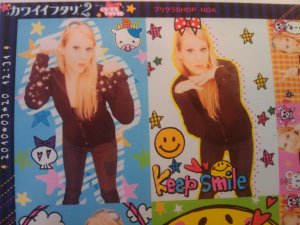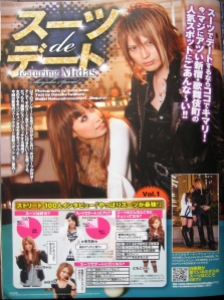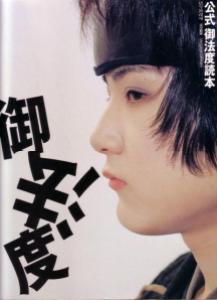If you go to Japan or have Japanese friends you’re bound to run into a purikura photo or photo booth. Purikura stands for purinto kurabu (プリント倶楽部), or print club. These photo booths were introduced in 1995 and by 1997 over 45,000 booths existed around the country (Okabe, Daisuke et al., pg. 1). It is popular with girls from the ages or 15 to 20. Virtually every Japanese high school girl take purikura photos and purikura is used as a way to visually display friendships and social networks to other (Okabe, Daisuke et al., pg. 2). Purikura are large photo booths that can hold anywhere from 4 to 8 people and offer a variety of background options for the users. After the photo has been taken, the girls can then go to a modification screen and write various kinds of ‘graffiti’ on their photos. They can also add image modifications to the photos, like makeup, different hairstyles, etc. The finished photos are printed out on sheets of self-adhesive stickers. Girls collect their purikura in photo albums as a sort of diary and carry the extra photos in a small container they call ‘puri-cans.’ High school girls look at their purikura albums with each other all the time, during lunchtime, after school, even in class. My students have given me purikura photos of themselves and their friends. Girls also exchange purikura photos with their friends. While some girls bring their boyfriends into purikura booths with them occasionally, the activity is mainly for girls (a Japanese boy would not own a purikura album).
Have you guys seen the old Coca-cola Zero commercials? They are ridiculously awesome…
“Hey, fat ass, just drink diet soda! It works for the Americans!” (Not an accurate translation)
This commercial spot ironically mocks the ‘Cool Biz’ (クールビズ) style that the government promotes in Japan to help cut down on air-conditioning and other types of electricity consumption. No one takes the Kyoto Protocol more seriously than Japan.
Way to go, Coca-cola. Let’s promote an image of anti-conformity while also alluding to samurai and ‘honorific individualism’ (if I can also allude to Ikegami Eiko’s book).
Clearly, Hosts are the Japanese counterpart to American Pimps. Except, rather than counting their ‘Benjamins’ and pouring champagne over their ‘hos,’ hosts compete to be the ‘King of Dandy’ and master the secret techniques of pleasing women (so she’ll beg to buy you that ¥300,000 D&G jacket). Rather than engaging in gangland warfare and trafficking drugs, these well-coiffed Japanese men battle amongst themselves for the coveted position of Number 1.
I, for one, can’t really decide which is more terrifying…wait, yes I can, the Hosts.
Well, for all you guys with dreams of hot women and tight designer pants, HOST KNUCKLE is here to help! Host Knuckle (or HOSU-NAKU if you prefer the affectionate Japanese abbreviation) is the magazine for hosts…or aspiring hosts…or bored Japanese housewives…or even more bored gaijin bloggers (me). The ~125 pages features lots of fashion spreads of really skinny Japanese dudes modeling intensely coordinated outfits in front of Shinjuku Kabukicho’s nightlife. I’d mention the hair…but that’d just be too easy. Crammed in-between the ads for Buffalo Bob’s, Midas, and VICE FAIRY (my personal favorite, NO VICE NO LIFE!), are informational articles about how to dress, the hippest new date spots in Kabukicho, and expos into the daily lives of REAL LIVE HOSTS! Not to mention a variety of ero guides (articles about how to entertain and please women), information on how pick the right hair salon to give you your own distinct hairstyle, and truly disturbing penile enlargement ads.
Even though I’m poking some fun at it, being a host is actually really hard work. It’s clearly not easy to drink yourself into a stupor every night, maintain cordial working relationships with your fellow hosts, and pretend that you’re attracted to the rich middle-aged woman who is paying you for your company. But don’t fret hosts, Host Knuckle is here to help you maintain you dandyish composure even in the most difficult situation!
Vol. 10 is dedicated to explaining the intricacies involved in the proper suit choice. It’s definitely not as easy as it looks – there’s the suit but then also the shirt, the shoes, and the myriad of jeweled accessories that you can pin to various places on your body. Thankfully, Host Knuckle usually narrows everything down into two options for you, so it isn’t all that hard. Do you want your coat to make you seem ‘wild’ or ‘intelligent?’ Should your suit be ‘dressy’ or ‘casual?’ Should you wear fake, lens-less glasses to give you an innocent ‘nerdy’ appeal or should you go for a more ‘mature’ image, perhaps by growing a bit of facial hair?
But don’t just take Host Knuckle’s word for it – the magazine regularly interviews the large amount of koakuma gyaru (the most recent evolution of the kogyaru – ganguro – kyabako species, see Koakuma AGEHA for more details) AKA the over-tanned Japanese girls who lurk in the recesses of the Shibuya 109 to verify this information for you. It turns out women really do prefer suits…even shiny ones with fur collars that make you look gay (for realzies!).
Think that this glamorous existence is impossible to obtain? Don’t fret, hosts are just normal guys who have mastered the arts of pleasing women and dressing well! HosuNaku breaks down their fashion secrets for you – now you’ve either got to dress like an high society kitsch rocker (whatever that is), develop a secret formula for ‘sexy pheromones,’ or summon the brutal strength of a python to win the hearts of your future sugar mamas. Another good quote – “Understanding the sweet and sour of life is the beginning of manhood.” Uhhhhhh, yeah.
But is being a host really a smart career choice? Sure, binge drinking and chain smoking might be fun when you’re 21, but does it really have a future? Well, don’t fear the glass ceiling. Look at this guy, he seems quite pleased…I bet his host club offers a fine pension plan for when he finally slips from the Number 1 spot. Maybe he’ll even open his own host club… Not unlike the host-with-a-heart-of-gold star of the recent television drama Tei-oh, which aired on TBS this past summer. It was an epic story of good triumphing over evil in the heart of the Roppongi host nightlife. For more, go to the show’s official website: http://www.tei-oh.com/
But of course, that leaves us with the most basic part of the job – pleasing women! Sure, they’re happy with you lighting their cigarettes and it definitely thrills them when you break societal norms and pour their drinks for them, but if you want them to really shell out the cash you need to get the latest Vice Fairy outfit…well, eventually you’ll probably have to sleep with them. And once more, HosuNaku is here to help. Remember – WHEN YOU ARE IN THE MIDDLE OF SEX, KEEP YOUR BODY CLOSE AND DO YOUR BEST TO PRETEND THAT YOU LOVE HER. Or just do a better job than the model in this feature…at least use more than two fingers to touch any part of her body.
(Warning, these pictures contain some nudity and simulated sex acts…don’t open them if they will offend you.)
Just follow Host Knuckle and you’ll be on your way to becoming the king of the elegant, dandyish, stardust celebrities in no time.
CORRECTION – Hosts aren’t the Japanese response to pimps after all…the Japanese response to pimps is…pimps. Or really tan dudes with facial hair and do-rags. Glide Media presents SOUL JAPAN, a do-it-yourself manual for the thug lifestyle. The upcoming Vol. 4 is a special edition featuring fashion AND favorite cars. I’m looking forward to seeing some pimped-out rides.
And now, thanks to the glory of YouTube, we now have our very own Host vloggers – http://www.youtube.com/watch?v=ELys5RKiE5s&feature=channel
危ない義理のできる男色
Oshima Nagisa’s 1999 film Gohatto is about desire and suspicion within the ranks of the Shinsengumi during the bakumatsu period. The film can be interpreted as both an examination of the destructive effects of desire within the brotherhood of the militia and as an allegorical criticism of the way modern Japanese society forces individuals to repress their desires for the sake of the group. While the second interpretation is entirely subjective, it is not unlikely given the fact that the director, Oshima Nagisa, commonly uses historical settings to criticize and examine modern society within his films. Furthermore, his failure to accurately reconstruct the sentiments of Tokugawa samurai during the mid-19th century within the film implies that Oshima Nagisa was more interested in using the subject matter to criticize modern society than in accurately reproducing the mentality of the time. It is clear that historical accuracy was not the primary concern of the director. Though Gohatto accurately portrays the environment and the official attitude of Tokugawa lawmakers towards shūdō (male-male relationships), its characters view the subject with an attitude that is far too modern.



















Recent Comments